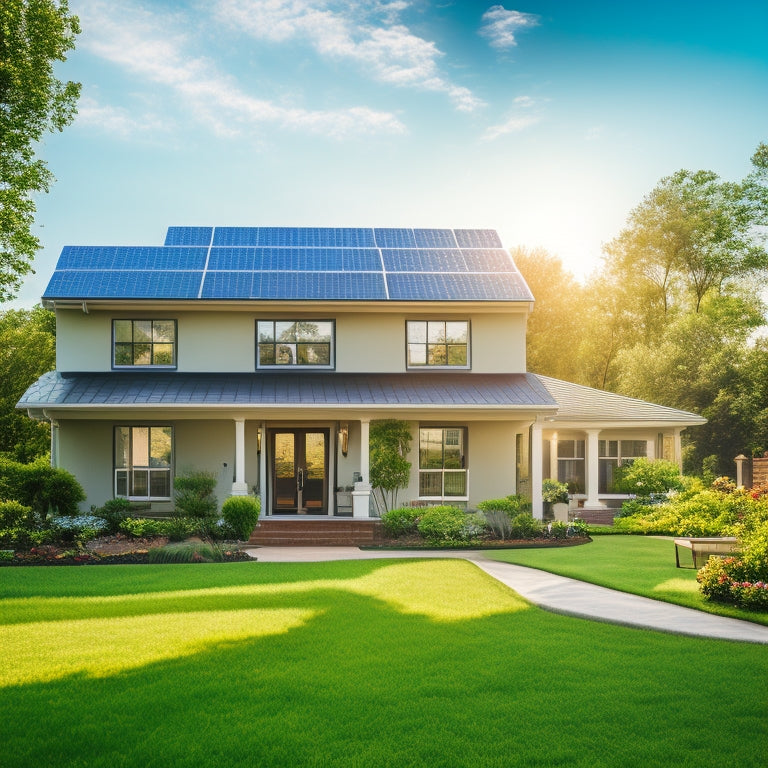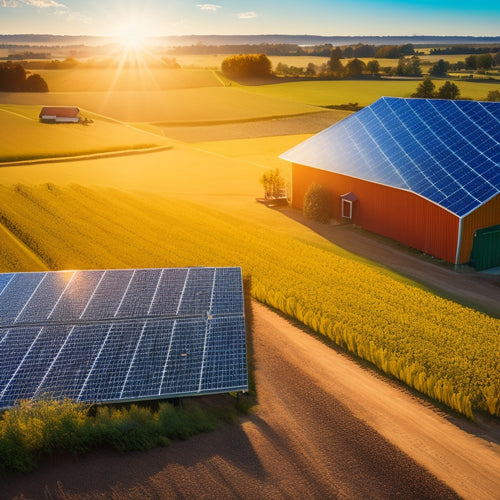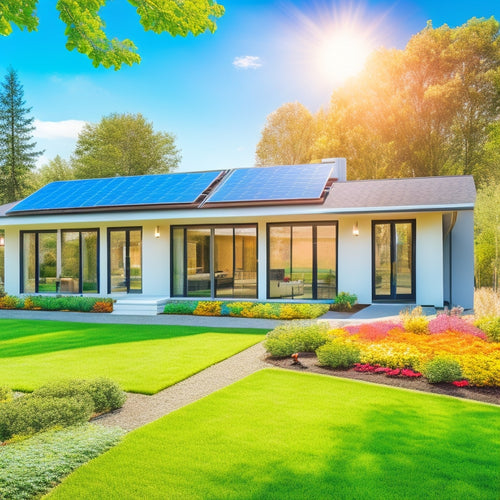
What to Know Before Checking Home Solar System Prices
Share
Before checking home solar system prices, you'll need to contemplate several key factors to guarantee you're getting the right system for your home. Start by understanding your energy needs, evaluating your roof's size, shape, and potential shade factors, and reviewing local incentives and rebates. You'll also want to research the types of solar panel systems, inverters, and mounting options available, as well as battery backup and energy storage solutions. Additionally, factor in permits, installation processes, and warranty and maintenance costs. By doing your due diligence, you'll be able to make an informed decision and maximize your solar investment - and there's still more to investigate.
Key Takeaways
- Analyze past utility bills to understand energy needs and correctly size your solar system for maximum savings and efficiency.
- Assess your home's solar potential by evaluating roof size, shape, and local shade factors to determine optimal panel placement.
- Understand the different types of solar panel systems, including grid-tied, off-grid, and hybrid, to choose the best fit for your energy requirements and budget.
- Research local incentives and rebates, such as tax credits, utility rebates, and government incentives, to reduce the overall cost of your solar system.
- Consider the warranty, maintenance costs, and installation process to ensure a smooth and cost-effective transition to solar energy.
Understanding Your Energy Needs
Before investing in a home solar system, it's essential to understand your energy needs. You need to determine how much energy you consume daily to size your solar system correctly. Analyze your past utility bills to calculate your average daily energy consumption in kilowatt-hours (kWh). This will give you an idea of the amount of electricity you need to generate.
Taking your energy consumption into account is important because it directly affects the solar savings you can expect. A correctly sized solar system will guarantee you maximize your solar savings. If your system is too small, you'll still rely on the grid, reducing your savings. On the other hand, an oversized system will increase your upfront costs without providing additional benefits.
To get an accurate estimate of your energy needs, evaluate factors like the number of people in your household, your appliances' energy efficiency, and your energy usage patterns.
You may also want to think about energy-efficient upgrades to reduce your overall energy consumption. By understanding your energy needs, you'll be able to design a home solar system that meets your requirements and provides maximum solar savings.
Assessing Your Home's Solar Potential
You'll need to evaluate your home's roof size and shape to determine how many solar panels can fit, and in what configuration.
Additionally, you'll want to assess local shade factors, such as nearby trees or buildings, that could impact the system's energy output.
Roof Size and Shape
Optimizing your home's solar potential begins with a thorough assessment of your roof's size and shape. A larger roof provides more space for solar panels, but it's not the only factor to evaluate. The shape of your roof also plays a significant role in determining how many panels can be installed and at what angle.
| Roof Characteristics | Impact on Solar Potential |
|---|---|
| Roof Orientation | Ideal orientation is south-facing, as it receives the most direct sunlight. East- and west-facing roofs are also suitable, but north-facing roofs are less ideal. |
| Roof Material | Asphalt shingles are the most common and easiest to work with. Metal, clay, or slate tiles may require additional installation considerations. |
| Roof Size | Larger roofs provide more space for solar panels, but may also increase installation costs. |
| Roof Obstacles | Skylights, vents, and chimneys can reduce available space for solar panels and affect their performance. |
Local Shade Factors
As your solar panel system's performance is heavily influenced by the amount of sunlight it receives, it's vital to assess the local shade factors that may impact your home's solar potential. A shade analysis is necessary to identify any obstacles that could reduce the system's energy output.
Trees, whether on your property or your neighbor's, can cast considerable shade, especially during seasonal changes. For instance, trees with leaves can block sunlight during spring and summer, while bare trees can still cast shade during winter.
To accurately determine the impact of shading on your solar system, you'll need to create shading diagrams. These diagrams will help you visualize the path of the sun throughout the day and year, highlighting areas where shade may occur.
By analyzing these diagrams, you can identify the best placement for your solar panels to maximize solar access. Don't underestimate the tree impact – even a small amount of shade can greatly reduce your system's energy output.
A thorough assessment of local shade factors will guarantee you get the most out of your solar panel system.
Types of Solar Panel Systems
Three primary types of solar panel systems cater to different energy requirements and installation scenarios.
You'll want to take into account these options to determine which one best suits your energy needs and budget.
Grid-tied systems are the most common type, connecting your solar panels to the grid and allowing you to sell excess energy back to your utility company.
This setup takes advantage of solar technology advancements, providing higher solar panel efficiency and reducing your reliance on the grid.
Off-grid systems, on the other hand, are designed for remote locations or areas with frequent power outages.
These systems typically include energy storage solutions, such as batteries, to provide power when the sun isn't shining.
Hybrid systems combine the benefits of both grid-tied and off-grid systems, allowing you to store excess energy and use it during power outages or at night.
Inverters and Mounting Options
Your solar panel system's performance relies heavily on the inverter, which converts DC power from the solar panels into AC power for your home. This essential component guarantees you can use the generated electricity to power your appliances and devices.
There are different inverter types, including string inverters, microinverters, and power optimizers, each with their advantages and disadvantages.
When choosing an inverter, consider factors such as efficiency, durability, and warranty.
You'll also need to decide on a mounting system for your solar panels. This can include:
- Roof-mounted systems, which are the most common and cost-effective option
- Ground-mounted systems, suitable for larger installations or those with limited roof space
- Tracking systems, which adjust the panel angle to maximize energy production
Your choice of inverter and mounting system will impact the overall cost and performance of your solar panel system.
Be certain to research and compare different options to find the best fit for your energy needs and budget.
Battery Backup and Energy Storage
Since you've selected your inverter and mounting system, it's time to contemplate how you'll store the excess energy your solar panel system generates. This is where battery backup and energy storage come in. With a battery storage system, you can store excess energy generated during the day for use at night or during power outages. This means you'll have a reliable source of power even when the grid goes down.
When considering battery backup and energy storage, you'll want to investigate different battery technology options. Look for deep cycle batteries specifically designed for solar applications, as they're built to handle the daily charge and discharge cycle.
Additionally, consider the storage capacity you need based on your energy usage patterns. Achieving energy independence is a significant benefit of incorporating battery backup and energy storage into your home solar system.
You'll be able to power your home with clean, renewable energy, reducing your reliance on the grid. By selecting the right battery technology and storage capacity, you can enjoy a reliable and sustainable source of power.
Local Incentives and Rebates
You'll be happy to know that local incentives and rebates can markedly reduce the upfront cost of your home solar system.
You may be eligible for state tax credits, which can provide a substantial credit against your state tax liability.
Additionally, you should investigate utility rebate options and local government incentives, which can further offset the cost of your solar system.
State Tax Credits
State governments offer additional incentives to encourage homeowners to invest in solar energy systems. These state tax credits can greatly reduce the cost of installing a solar panel system.
As you examine your options, it's crucial to understand the tax benefits available in your state. To determine your state's eligibility, research the specific tax credits offered. Some states provide a percentage of the total system cost, while others offer a fixed dollar amount. Additionally, some states allow you to claim the tax credit over multiple years.
- Check if your state offers a refundable or non-refundable tax credit.
- Find out if there are any caps on the total amount of tax credits available.
- Determine if the tax credit can be carried over to future years if you don't use the full amount in the first year.
Remember to factor these state tax credits into your overall cost calculation to get an accurate estimate of your solar panel system's price.
Utility Rebate Options
Opportunities abound for homeowners to capitalize on local incentives and rebates offered by utility companies, further reducing the cost of going solar. These rebates can greatly lower your upfront costs, making solar energy more accessible. Before checking home solar system prices, it's crucial to investigate the utility rebate options available in your area.
| Utility Company | Rebate Amount | Eligibility Requirements |
|---|---|---|
| Pacific Gas & Electric (PG&E) | Up to $1.25/watt | Residential and commercial customers |
| San Diego Gas & Electric (SDG&E) | Up to $1.10/watt | Residential and commercial customers |
| Southern California Edison (SCE) | Up to $1.15/watt | Residential and commercial customers |
In addition to these local incentives, you can also take advantage of federal incentives, such as the Solar Investment Tax Credit (ITC). Combining these incentives with financing options, like solar loans or power purchase agreements, can make going solar even more affordable. By understanding the utility rebate options available, you can make an informed decision when checking home solar system prices.
Local Government Incentives
Besides utility company rebates, local government incentives can also greatly reduce the cost of going solar. As you investigate your options, you'll find that local governments offer various incentives to encourage the adoption of renewable energy. These incentives can include property tax exemptions, sales tax exemptions, or even low-interest loans.
Some local governments also offer additional benefits, such as:
- Streamlined permitting processes to reduce installation costs and timelines
- Zoning regulations that allow for more flexible solar panel installations
- Special financing options, like Property Assessed Clean Energy (PACE) financing, which enables you to pay for your solar system through your property taxes
Keep in mind that local incentives often complement federal incentives, such as the Solar Investment Tax Credit (ITC).
Permits and Installation Process
Your solar panel installation is about to become a reality, but before the panels go up, you'll need to maneuver through the permits and installation process. This stage can be complex, but understanding what's involved will help you guide through it smoothly.
Solar permitting is a vital step, as it guarantees your system meets local building codes and regulations. Your installer will typically handle the permits, but it's important to know what's involved. They'll submit plans and wait for approval, which can take several weeks to a few months, depending on the jurisdiction.
Once permits are in place, the installation timeline begins. This typically takes 2-5 days, depending on the system size and complexity.
The installer will set up the mounting system, install the panels, and connect them to the inverter. They'll also connect the system to your electrical panel and verify everything is working correctly.
After installation, the city or county will inspect the system to confirm it meets code requirements. With permits and installation complete, you'll be ready to flip the switch and start generating clean energy.
Warranty and Maintenance Costs
Now that your solar panel system is up and running, it's time to think about protecting your investment and guaranteeing it continues to perform effectively over its lifespan.
A thorough warranty and regular maintenance are vital to maximizing your system's energy production and extending its lifespan.
When evaluating warranty options, consider the warranty duration and what it covers. A typical warranty lasts between 10 to 25 years, but some manufacturers offer longer or more extensive warranties.
Make certain you understand what's covered, including parts, labor, and performance guarantees.
- Regular cleaning to guarantee peak energy production
- Scheduled inspections to identify potential issues before they become major problems
- Software updates to guarantee your system remains compatible with advancing technology and regulations
Frequently Asked Questions
Can I Install Solar Panels on a Rented Property?
You'll need to check your renter rights before installing solar panels on a rented property, as it may require permission from your landlord; however, installation options like community solar programs or portable solar panels might be viable alternatives.
Do Solar Panels Work During Power Outages?
You'll find that solar panels don't work during power outages, unless you have energy storage options like batteries, which can provide backup power when the grid is down, maximizing your solar panel efficiency.
Are Solar Panels Pet-Friendly and Bird-Safe?
As you envision a solar-powered haven, you wonder: are solar panels pet-friendly and bird-safe? Rest assured, modern solar panel materials are designed with wildlife protection in mind, ensuring a harmonious coexistence between your energy-efficient home and the creatures that visit.
Can I Sell Excess Energy Back to the Grid?
You can sell excess energy back to the grid through net metering, earning energy credits that offset your utility bills; this benefit allows you to maximize your solar investment and reduce your reliance on the grid.
Do Solar Panels Void My Roof's Warranty?
Fasten your seatbelts, flux capacitor-style, because we're diving into roof warranty impacts! When you install solar panels, you'll want to guarantee the installation doesn't void your roof's warranty; research the manufacturer's terms and choose an installer who'll handle installation considerations with care.
Conclusion
Now that you've got the lowdown on what affects home solar system prices, you're probably thinking, "Great, I'm ready to save the planet and my wallet!" Not so fast. Remember, you're about to invest in a complex system that'll be stuck on your roof for decades. Don't rush into it. Take your time, do your research, and don't let those pesky salespeople sweet-talk you into a bad deal. Your wallet (and the planet) will thank you.
Related Posts
-

Off-Grid Solar Solutions for Sustainable Farming
Off-grid solar solutions can revolutionize your farming operations by providing energy independence and significant c...
-

How Solar Panels Increase Property Value
Installing solar panels considerably increases your property value by improving energy efficiency and attracting eco-...
-

High-Performance Energy-Efficient HVAC Systems
High-performance energy-efficient HVAC systems are essential for reducing energy consumption while improving indoor c...


